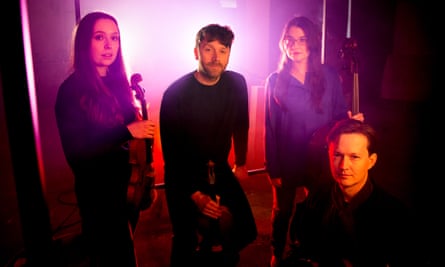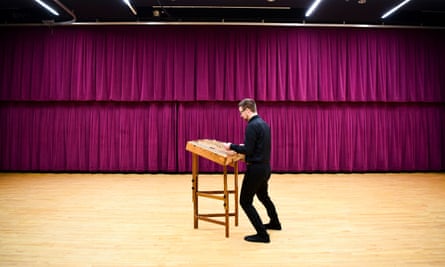10. Neil Gaiman and FourPlay String Quartet – Signs of Life
Sydney-based string quartet FourPlay have made a name by playing versions of music by various rock and jazz artists, including Radiohead and Metallica, but they have also been working with the fantasy writer Neil Gaiman for more than a decade. Here they provide a series of wonderfully quizzical, meandering accompaniments as Gaiman recites deeply humanistic prose and poetry about truth, lies, death, Joan of Arc and the “casual genocide” of Indigenous Australians. His verses can be horrific, mini-horror movies, like The Wreckers, or amusingly whimsical and Ivor Cutler-ish, like Möbius Strip.
9. Joel Styzens – Resonance
Chicago multi-instrumentalist and composer Styzens plays hammered dulcimer and classical guitar in this unorthodox outfit which also features Illinois jazz pianist Rob Clearfield, British cellist Sophie Webber and the Atlys String Quartet. You would broadly describe the music they make as minimalism, but where so much minimalism can be insistent, grating and aggravating, this is a form that does not play mathematical games or create fractal patterns – it is lush, comforting music that yearns and soothes.
8. Thomas Adès/Los Angeles Philharmonic – Dante
To accompany Wayne McGregor’s ballet production of Dante’s The Divine Comedy, the British composer Thomas Adès devised this incredibly ambitious piece in three movements. The first, Inferno, is a bombastic tone poem that lurches between horror-movie modernism and nods to Liszt and Berlioz. The woozier second section, Purgatoria, sets Middle Eastern musical tropes against distorted recordings of singers from Jerusalem’s Great Ades Synagogue (a place distantly related to Adès’s Syrian Jewish ancestors). The finale, Paradisol, is an ecstatic, spiralling, slurring piece of 12-tone serialism. These are pastiches, yes, but brilliantly done.
7. Anna Meredith and Ligeti Quartet – Nuc
Tuggemo, the opening track on this collaboration between the Scottish composer and the London-based string quartet, is a conscious nod to rave culture, something often near the surface with Meredith’s music. But the most interesting tracks here push the string section to its limits: the microtonality of Honeyed Words, the shimmering irradiance of Chorale, or the wonderfully demented minimalism of Shill. The Ligeti also revive Meredith’s 2013 composition A Short Tribute to Teenage Fanclub, which doesn’t seem to quote the Glasgow janglers at all but which features a series of downward scales that become increasingly, and joyously, shambolic as the piece progresses.

6. Galya Bisengalieva – Polygon
London-based Bisengalieva is best known as the lead violinist in Robert Ames’s London Contemporary Orchestra and for her work with Radiohead’s Jonny Greenwood and Thom Yorke. Here, on her second LP as a composer and leader, she turns to the grim story of a facility in her native Kazakhstan, where the Soviet military tested hundreds of nuclear weapons, poisoning the population and destroying the ecology. Like Hildur Guðnadóttir’s soundtrack to Chernobyl, it recreates echoey chambers and the sound of geiger counters, but Bisengalieva envelopes these tracks with string arrangements that are both lush and terrifying.
5. Naoko Sakata – Infinity
Born in Japan and based in Gothenburg, Sweden, pianist Sakata plays with a striking fierceness and energy. This album of improvisations, apparently guided by tarot and numerology, melds dozens of different styles. She moves from bowel-quaking low-end rumbles to glistening high-end flourishes; from hymnal, rubato-heavy, Keith Jarrett-like ruminations to Conlan Nancarrow-ish jabbering; from Cecil Taylor freakouts to moments of utter precision. It’s released on Pomperipossa, a label run by the organist Anna von Hausswolff, and Sakata shares Von Hausswolff’s sense of the gothic, but this is truly idiosyncratic music.
4. Lisel – Patterns for Auto-Tuned Voices and Delay
The American singer Eliza Bagg, AKA Lisel, has constructed a piece of chamber music for the human voice, multitracked and fed through myriad effects units. It is haunting and beautiful, from the Dada-esque babble of One at a Time to the Gregorian chant-goes-Dilla minimalism of Plainsong; from the disquieting Wicker Man chant of Immature to the full-throated holler of Stalactite, where her voice starts to shimmer and sparkle. Lisel’s music also raises fundamental questions: once a voice has been treated digitally, is it still human, or a freakish cyborg simulacrum? Read the full review

3. Matthew Halsall – An Ever Changing View
Over nine albums, Halsall has made his name as Manchester’s answer to Sun Ra, his spiritual jazz melding ecstatic freakouts, swirling harps, modal piano flourishes and exotic instrumentation, all melded by Halsall’s Don Cherry-style trumpet. Here he retreats to rural north Wales and moves in a more consciously meditative, bucolic direction. The Alice Coltrane-ish harps have been replaced by thumb pianos and assorted tuned percussion – glockenspiels, marimbas, triangles, bells – all woven together with piano, Fender Rhodes, ruminative flute and sax solos and recordings of birdsong to create an ethereal piece of chamber music. Read the full review
2. Wild Up – Julius Eastman Vol 3: If You’re So Smart, Why Aren’t You Rich
The music of the Black, gay, impish and provocative American composer Julius Eastman has been far more appreciated in the decades since his death 33 years ago. The sonically omnivorous LA collective Wild Up have been painstakingly recreating his compositions in an ongoing series of albums since 2021, assembling arrangements from fragments of recordings and scraps of surviving scores. The 20-minute title track contains a series of rising and falling chromatic scales that are slowly ripped apart; The Moon’s Silent Modulation is an episodic piece of surrealism, complete with operatic harmonies and discordant pianos. Best of all is the sensual, jabbering, high-intensity, maximal minimalism of the unsettling Evil N****r. Urgent and compelling music that seems to have finally found its time. Read the full review
1. Miguel Atwood-Ferguson – Les Jardins Mystiques Vol 1
One of the most important musicians working in the US, California’s Miguel Atwood-Ferguson has worked on more than 600 albums, arranging, composing, conducting or playing violin, viola or cello with the likes of Ray Charles, Seu Jorge, Mary J Blige, Flying Lotus and the percussionist Carlos Gabriel Niño. This is his debut as leader, drawn from sessions he’s recorded over the last decade, and it’s an absolute epic – a three-and-a-half-hour triple LP that takes us through glistening Romantic-era impressionism, minimalism, orientalism, John Coltrane-ish modal musings, Alice Coltrane-ish harp-heavy mysticism and even synthesised soundscapes that sound like Bach recreated for an 8-bit video game. A masterpiece.

